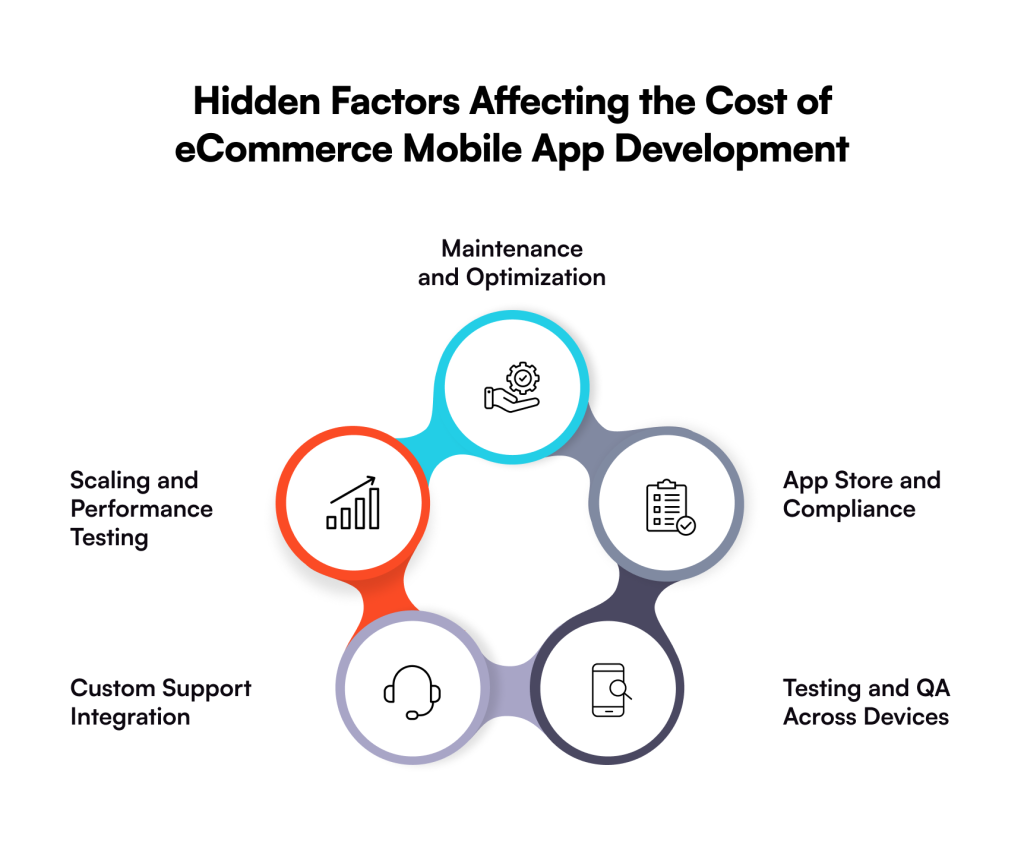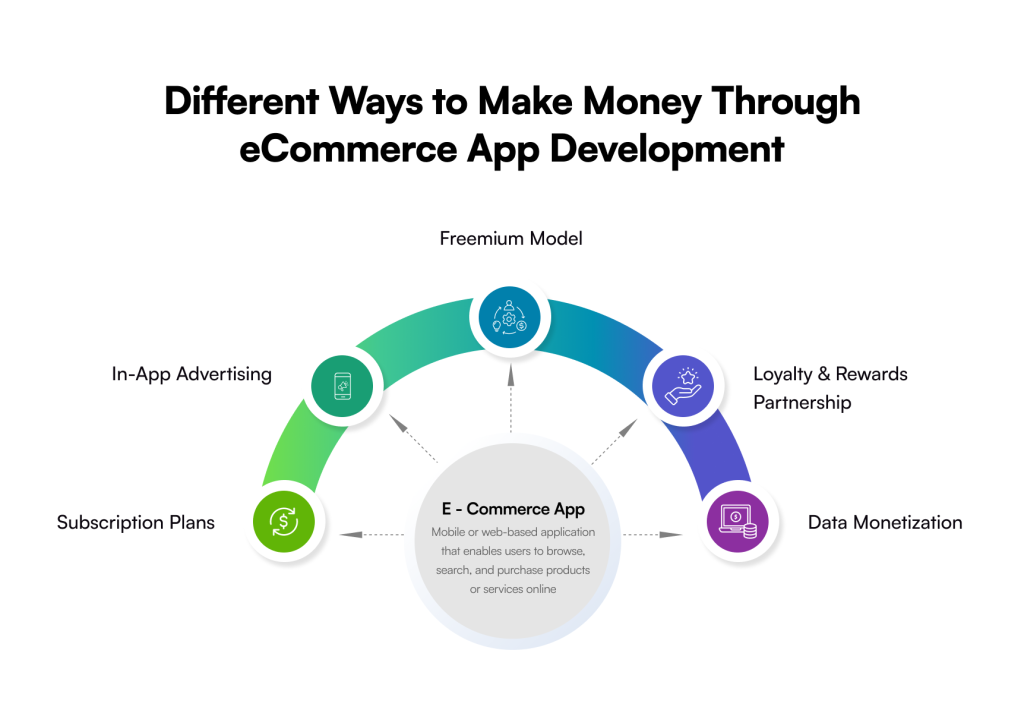Are you considering developing an eCommerce app but are concerned about the expense? With the help of this guide, you may prepare with confidence by uncovering hidden aspects, actual data, and cost-effective advice.
Having an eCommerce app is not an option in today’s digitally-first marketplace; it is a must. Global retail eCommerce sales topped $4.3 trillion in 2025. Nevertheless, companies that have yet to make an investment in mobile commerce run the danger of missing out on a significant source of income.
But one of the first and important questions that comes into every entrepreneur, startup, or enterprise’s mind is: “How much does an eCommerce app development cost?” Now, to give you an answer, there is no definite number. This is due to the fact that it depends on a variety of factors, including platform selection, third-party integrations, app complexity, and more.
We have produced a comprehensive guide to assist you in determining the precise cost of developing an eCommerce mobile app. We’ll outline the main factors that influence eCommerce app development expenses, provide reasonable price estimates, and point out ways to cut costs without sacrificing quality.
Factors Affecting the Cost of eCommerce App Development
If you are expecting a straightforward answer to “how much does it cost to create an eCommerce app?”, you might not get one. Do you know why? There are multiple factors influencing the cost of eCommerce app development.
Here are the top 5 factors that might break your bank a little, but they will be worth every penny once you start receiving higher ROI:
- App Complexity & Features
Naturally, a basic eCommerce software with features like product listings, a shopping cart, and secure payments will be less expensive than one with advanced analytics, AR try-on, or AI-driven suggestions. The cost increases as more features are added.
- Design & User Experience
An eCommerce app’s UI/UX has a direct impact on conversions in eCommerce; it’s not simply about appearances. Although it requires more time (and money), a well-designed, user-friendly layout with seamless navigation and customized experiences results in increased client retention.
- Platform Choice
It is less expensive to build for one platform, but development expenses will go up if you want your program to run on both iOS and Android. To strike a compromise between reach and budget, many companies choose cross-platform frameworks like Flutter or React Native.
- Tech Stack & Integrations
Cost is significantly influenced by the backend technology, payment gateways, CRM/ERP integrations, and APIs you use. For instance, using sophisticated third-party solutions (such as bespoke analytics or AI chatbots) raises the total outlay.
- Development Team’s Location
Your choice of backend technology, payment gateways, CRM/ERP integrations, and APIs greatly influences the price. The total investment is increased, for instance, by incorporating sophisticated third-party solutions (such as AI chatbots or custom analytics).
Here is an estimated cost for each platform:
| App Platform | Basic App | Mid-Level App | Complex App |
| Android App Development | $5,000 to $15,000 | $15,000 to $30,000 | $72,000 and increasing |
| iOS App Development | $5,000 to $25,000 | $25,000 to $75,000 | $75,000 to $150,000+ |
| Cross-Platform Development | $5,000 to $20,000 | $20,000 to $70,000 | $70,000 to $250,000+ |

Hidden Factors Affecting the Cost of eCommerce Mobile App Development
The total cost of developing an eCommerce software can be significantly increased by hidden costs like maintenance or support, which go beyond the obvious elements like features or design. You can save a lot of money if you can identify them early.
The following are a few hidden fees that you should avoid.
- Maintenance and Optimization
You cannot overlook post-launch optimization and maintenance services because you will not only make your eCommerce app error-free, but it will also stay up-to-date. So, this might cost you money, yet they are crucial to make your app functional and competitive.
- App Store and Compliance
If you think publishing your app on the Google Play Store or App Store is free, you are wrong because it does require annual fees. Apart from this, adhering to the respective marketplace’s policies is a different addition to the cost, and rejecting them will automatically increase the price.
- Testing and QA Across Devices
Real-world testing isn’t going to work; you must make sure your eCommerce app is being tested across multiple devices, screen sizes, and OS versions. Additionally, user research testing is also being conducted to make sure the user experience remains intuitive and up-to-the-mark. So, this kind of testing demands dedicated resources that ultimately lead to an increased price.
- Custom Support Integration
Integrating live chat support in an eCommerce app is a must to resolve customer queries instantly without hampering their experience. So, the third-party integrations come with a cost, which you must pay only to avoid the increasing bounce rate in the future.
- Scaling and Performance Testing
When your eCommerce app starts scaling and starts experiencing high transaction volumes, you must optimize your app. Performance tuning or caching strategies are some of the hidden charges that come up while your app scales.

How You Can Make Money Through an eCommerce Mobile Application?
Now that you are spending money on developing an eCommerce app of your dreams, it is crucial to know how you can earn a profit out of it. Below is a list of some of the effective ways:
- Subscription Plans: With this, users pay a recurring monthly or yearly fee for premium features or an ad-free experience in your eCommerce application.
- In-App Advertising: You can make money through interactive ads, videos, or native ads by displaying them in your eCommerce app.
- Freemium Model: You can attract users and provide them with the basic features for free, and in case of utilizing the advanced features, you can charge them.
- Loyalty & Rewards Partnership: Partner with other companies or service providers to provide consumers with special offers, rebates, or incentives for making regular purchases or using the app.
- Data Monetization: By offering market insights to outside researchers, companies, or advertisers who want to learn more about consumer behaviour, the anonymized and aggregated data can be made profitable in a number of ways.

Partner with Galaxy Weblinks to Build a Cost-Effective eCommerce Mobile App Development
Although the price of developing an eCommerce software may seem prohibitive, the true query isn’t “How much will it cost?” “How much value will it create?” is the real question.
At Galaxy Weblinks, we make sure every dollar you invest works harder for you, whether you’re developing a full-featured eCommerce platform with sophisticated integrations or launching a lean MVP to test your idea.
We concentrate on striking the ideal mix between price, quality, and scalability so that you receive more than simply an app; you receive an engine that generates income. Working with Galaxy Weblinks entails more than just development; it entails having professionals on your side to create an eCommerce app that is ready for the future and will pay for itself many times over.
You can get in touch with our expert team, which can guide you and turn your app idea into reality!
FAQs
1. How much does it cost to develop a basic eCommerce app?
A simple eCommerce app with core features like product listings, cart, and secure checkout typically costs between $15,000 – $30,000. However, the price can go higher depending on design complexity and integrations.
2. What factors influence the cost of eCommerce app development the most?
The biggest cost drivers are features, app complexity, design (UI/UX), chosen platform (iOS/Android), integrations, and developer location. Advanced features like AI recommendations, AR try-on, or multi-vendor support significantly increase development costs.
3. Is it cheaper to build an app for iOS or Android?
Developing for a single platform is usually cheaper than building for both. The cost difference between iOS and Android isn’t huge, but if you want to target both, opting for cross-platform frameworks like Flutter or React Native can be more budget-friendly.
4. Do I need to budget for app maintenance after launch?
Yes. Post-launch costs include bug fixes, server costs, updates, and new feature rollouts. On average, businesses spend 15–20% of the initial development cost annually on maintenance.
5. How can I reduce the cost of developing an eCommerce app?
You can optimize costs by starting with an MVP (Minimum Viable Product), choosing the right tech stack, using cross-platform development, and partnering with an experienced development team that balances cost with quality.


